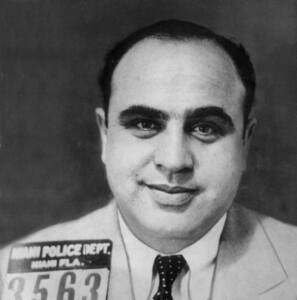Saint Valentine’s Day Massacre
 Between 1924 and 1930, the city of Chicago became one of the largest centers for gang activity in the country. Following the ratification of the 18th Amendment, Prohibition led to the rise of bootlegging, giving many gangs a way to make money and connections in their cities. These crime bosses would protect their business interests and allies through any means necessary: intimidation, bribes and, most notably, execution.
Between 1924 and 1930, the city of Chicago became one of the largest centers for gang activity in the country. Following the ratification of the 18th Amendment, Prohibition led to the rise of bootlegging, giving many gangs a way to make money and connections in their cities. These crime bosses would protect their business interests and allies through any means necessary: intimidation, bribes and, most notably, execution.
On the morning of February 14, 1929, two men dressed as police men entered a warehouse. Lining up the seven men inside in front of a wall like it was a raid, the men, joined by two others dressed as civilians, pulled machine guns and other weapons from their jackets and opened fire. 70 bullets later, all seven were dead or dying on the floor, soaked with blood.
This gruesome crime was no raid-gone-wrong. The warehouse at 2122 N. Clark Street was used to store liquor by George “Bugs” Moran. His North Side gang was a thorn in the side of the notorious gangster Al Capone. Capone, having taking over from his boss Johnny Torrio in 1925, was known for controlling his illegal organization with a ruthless iron fist, usually choosing to gun down his enemies. Moran was the only thing in the way of Capone’s crime syndicate in its quest to dominate over all gang activity in the entire city of Chicago. The two gangs had been at odds for months: Moran’s gang hijacking Capone’s shipments, killing his allies and providing competition for business. By 1929, tension between the two gangs had reached a boiling point.
When news of the crime broke later that day, all suspicions fell immediately on Capone. Frank “Hock” Gusenberg, Moran’s enforcer, was the only one still alive when law enforcement arrived at the garage, but refused to reveal anything before he died from his injuries several hours later. Moran himself, who wasn’t at the warehouse at the time, said that, “Only Capone kills like that.” It is suspected that Moran was the intended target of the massacre but he arrived later than the others and saw the fake police officers entering the warehouse and fled the scene thinking it was a raid. Capone himself was in Florida at the time, giving him an iron clad alibi. No one was ever arrested or tried for these crimes due to the lack of distinct evidence, but the massacre was eventually accredited to Capone’s gang. The massacre led to the diminishment of Moran as a figurehead in the Chicago gang circuit, leaving Capone to completely rule over the city through his syndicate until he was arrested and convicted of tax evasion in 1931.
The crime itself was seared into the history of Chicago, immortalizing the gun violence, bootlegging and the evolution of the criminal underworld that filled the streets during the Prohibition era. The crime continues to be a figure for the city even though the scene of the crime was destroyed in 1967.
Back to Organized Crime
Back to Crime Library
|
|
|

